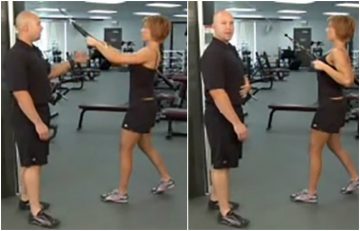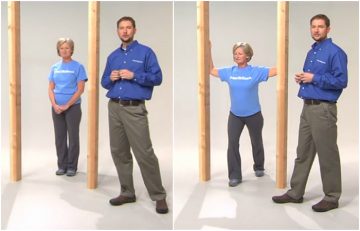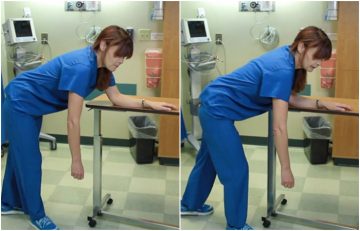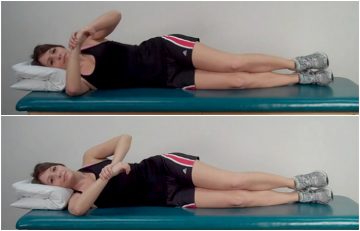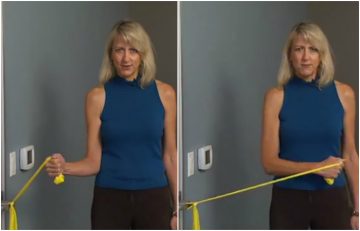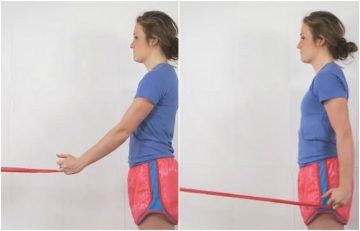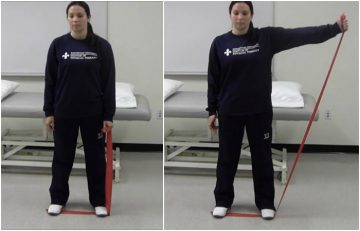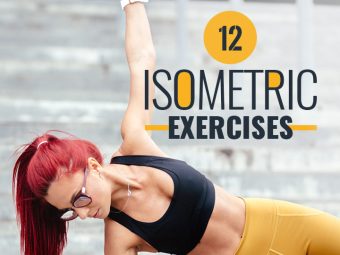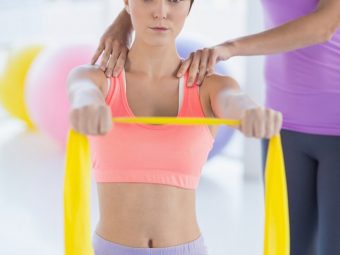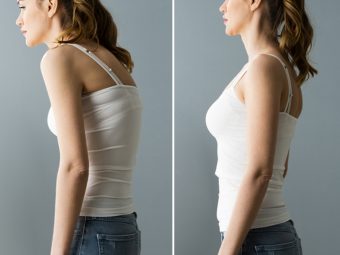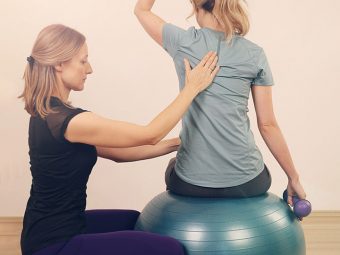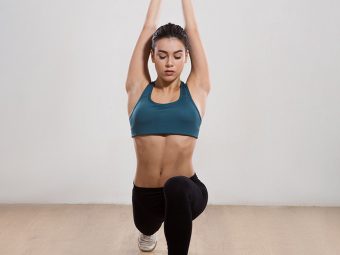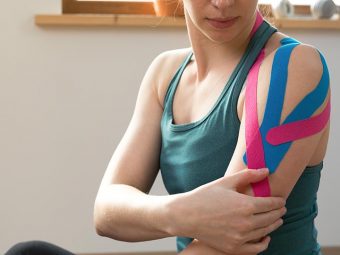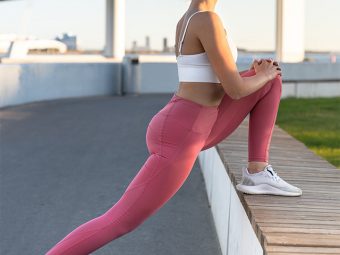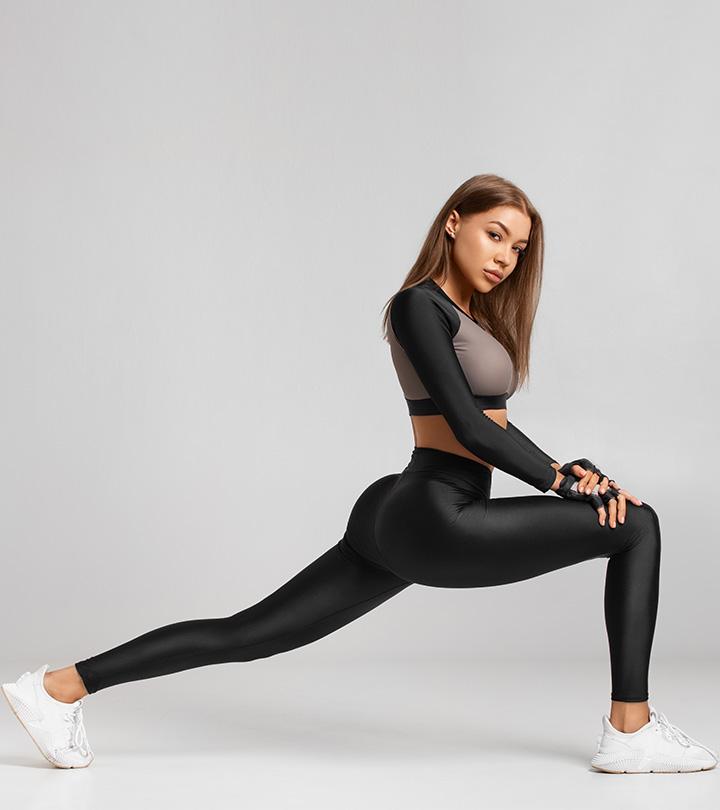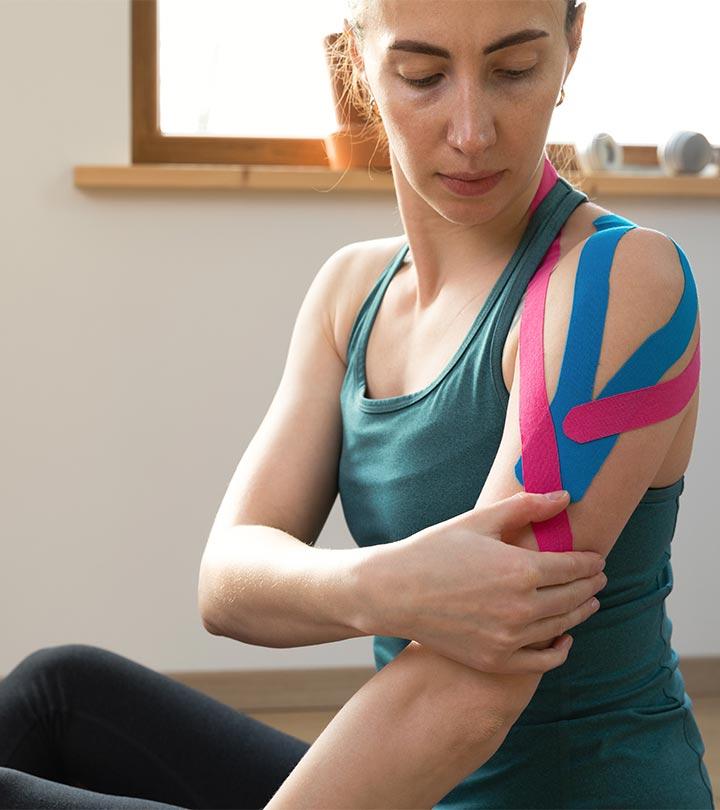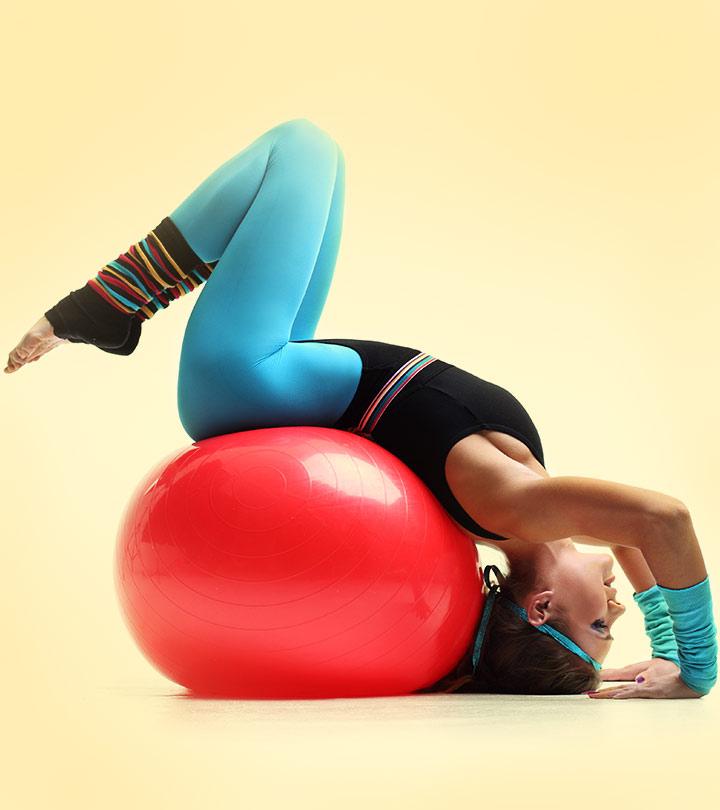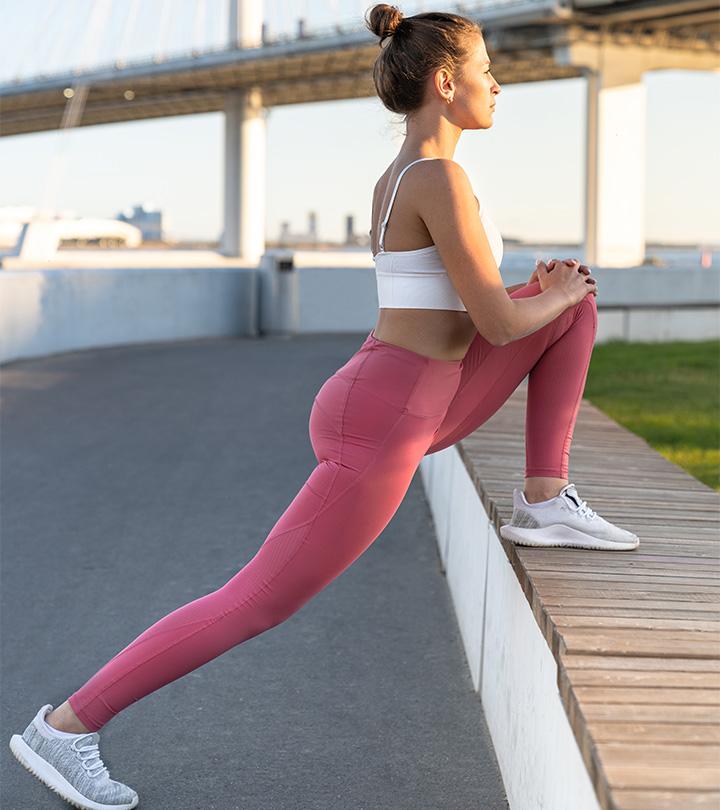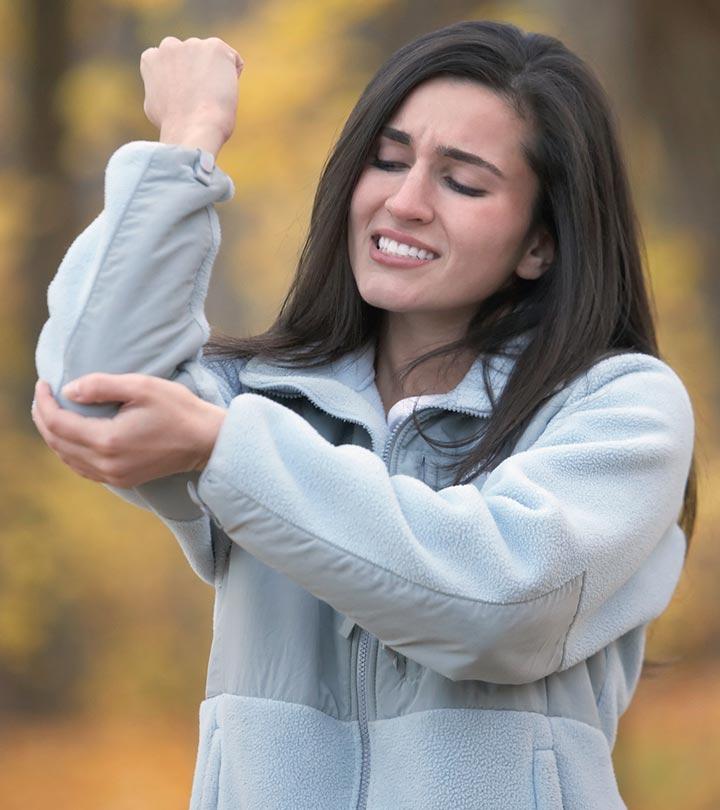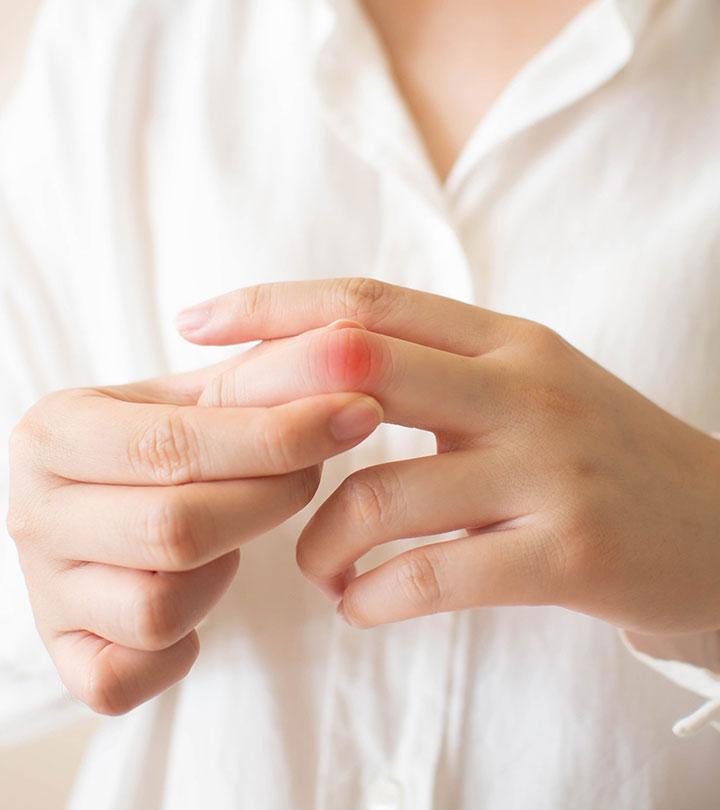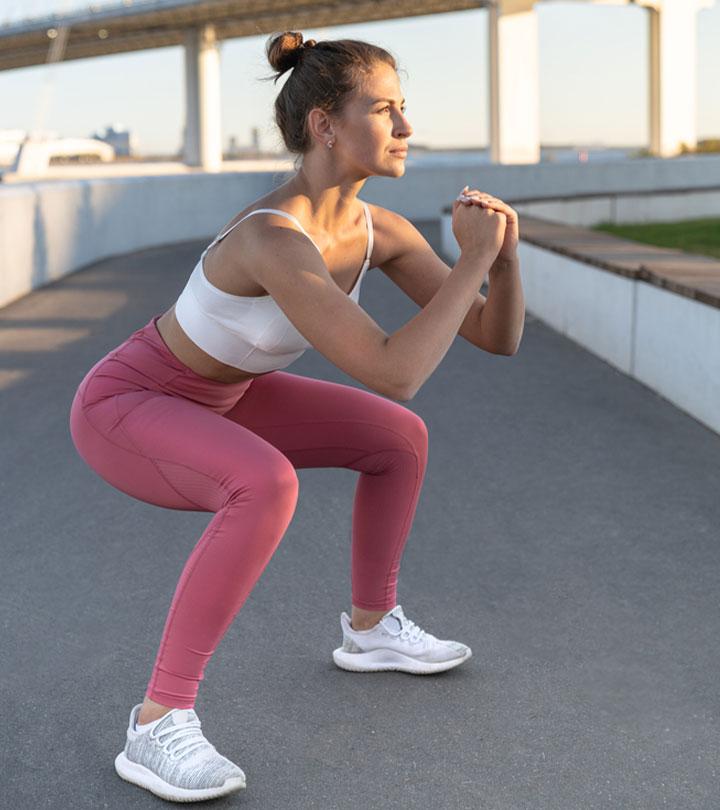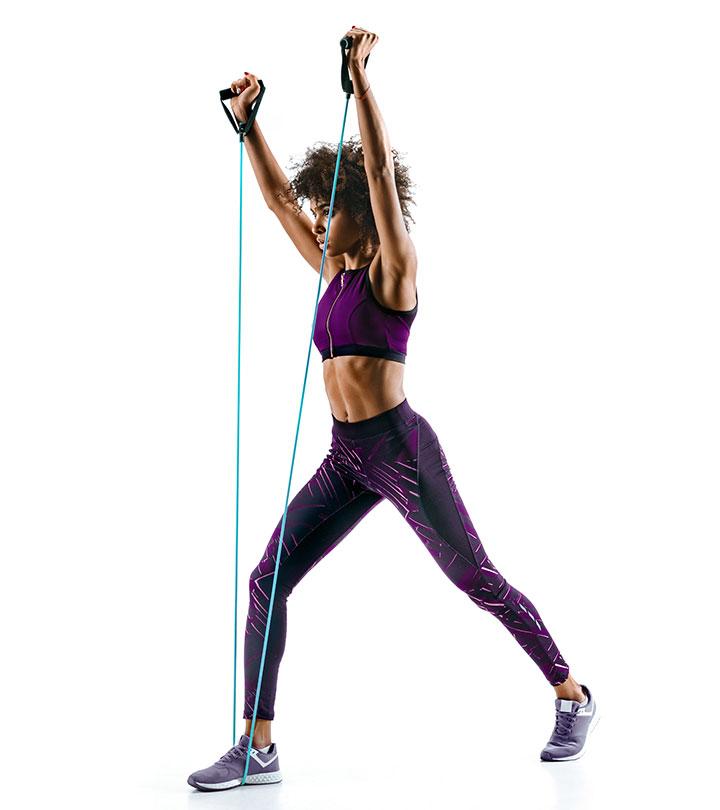How To Reduce Shoulder Pain – 13 Best Rotator Cuff Exercises
Follow these simple stretches to relieve the stress and pressure on your shoulders.

Image: ShutterStock
The rotator cuff is a small group of muscles that rotates your shoulder and therefore helps control its movements. Rotator cuff exercises keep your shoulders strong and pain-free and help to rehabilitate any shoulder injury. The main symptom of a rotator cuff injury is a constant dull pain in the front or side of your shoulder. Lifting your arm up or doing daily chores can become extremely painful. Strengthening the rotator cuff muscles through physical therapy exercises can help reduce the pain and heal the muscles. You will be able to move your arm freely, lift objects without pain, and do daily chores with ease. Here are a few rotator cuff exercises you can do. Scroll down!
Note: Take your doctor’s permission before doing these exercises.
 Rotator Cuff Exercises
Rotator Cuff Exercises- Frequency: 3-5 times per week
- Benefits: Strengthen the shoulder muscles and reduce shoulder pain.
- Equipment Needed: Exercise mat, dumbbells, resistance band.
- Space Required: Small area
- Assistance Required: Yes, for certain exercises
- Who Should Avoid: Anyone with a rotator cuff injury or a history of shoulder issue.
In This Article
What Are The Rotator Cuff Muscles?
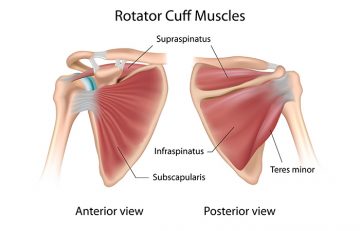
Understanding shoulder anatomy is important for both injury prevention and enhancing shoulder mobility.
The rotator cuff muscles are a group of four shoulder muscles that support the movements of your arms and shoulders. Also referred to as SITS, the four muscles of the rotator cuff are:
- Supraspinatus
- Infraspinatus
- Teres Minor
- Subscapularis
These muscles help stabilize your shoulders and move them in, out, up, back, and down when your arms do various tasks.
Without enough strength, balance, and stability in the rotator cuff, it would be impossible to lift your arms and do various movements freely. If you ever had a shoulder injury, you know that even lifting your hand can become extremely painful. So, what causes rotator cuff muscle weakness or pain? Find out in the next section.
What Causes Injury To The Rotator Cuff Muscles?
Injury and pain to the rotator cuff muscles are caused by weakness in the rotator cuff muscles combined with the overuse of your hands, arms, and shoulders – the muscles cannot support the movement of your limbs. Poor posture and incorrect form may also lead to irritation, inflammation, calcificationi XAn abnormal process of accumulation of calcium salts in the body tissues, causing them to harden. , degenerative thinning, and tendon tear in the area. A rotator cuff muscle injury can also occur due to aging. Here is a list of possible rotator cuff injuries:
- Rotator Cuff Tears
- Rotator Cuff Tendinopathyi XA broad term that includes all the painful conditions occurring in and around the tendons due to its overuse.
- Rotator Cuff Tendinitisi XAn inflammation or irritation of tendons (thick fibrous connective tissue) that attach muscles to bone.
- Shoulder Impingement Impingement Syndromei XShoulder pain caused by connective tissue due to inflammation from repetitive shoulder activities.
- Shoulder bursitis
When any of these four injuries occur, you may experience pain and other symptoms, such as:
Symptoms Of Rotator Cuff Injury
- Trouble lifting your hands
- Trouble reaching behind your back
- Weakness of the shoulders
- Trouble bearing weight on your hands in a plank
- Difficulty sleeping on the side of the affected shoulder
- Crackling sensation while doing certain movements
- Increased shoulder pain at night
If you have any of these symptoms, you must check with your doctor immediately. Your doctor will ask about your daily activity routine, medical history, and age, do a physical examination, and may ask you to get an X-ray and/or MRI done.
If a rotator cuff injury is confirmed, you may need to take NSAIDs (Non-Steroidal Anti-Inflammatory Drugs), physical therapy, or may require shoulder surgery if your injury is severe.
Donna Westermeier, a YouTuber, shared her experience of recovery from a shoulder injury after she fell off the stairs. Initially, she took physical therapy for it and it helped. However, she adds, “After three months of physical therapy, the doctor felt that my strength wasn’t where it should be and so, ordered an MRI– and the MRI found a large partial tear in my rotator cuff tendon a supraspinatus, and a slap lesion as well (i).” She eventually had to undergo surgery to treat the condition.
Post-surgery, the recovery will take place in four different stages:
- First, your shoulder will be immobilized for 4-6 weeks so the surgical area can help.
- Second, you will do passive movement exercises for 4-6 weeks, where the physical therapist will stabilize your arm at a particular position and gently exercise the shoulder rotator cuff muscles without any effort from you. This will help regain the shoulder’s range of motion, flexibility, and shoulder stability.
- Third, you will perform active exercises for 3-6 weeks to further improve your range of motion, add strength, and increase flexibility.
- Fourth, you will perform strength training exercises for 8-12 weeks using resistance bands and light weights to strengthen the muscles.
In this post, I will talk about the shoulder strengthening exercises recommended in the third and fourth stages of recovery. You will learn about the various active shoulder exercises you may perform under the supervision of your physical therapist. Talk to your doctor and therapist before starting these exercises to boost your shoulder health. At any time, if you experience increased pain, stop immediately and seek medical attention.
With these points in mind, let’s see which exercises are best for increasing strength, stability, and range of motion after a rotator cuff injury.
Top exercises used by physiotherapists were statistically evaluated in a recent study published in Musculoskeletal Care to determine the most suggested exercise for treating rotator cuff injuries. Participants from various countries took part in the survey to help analyze which exercise is recommended the most by physiotherapists. The graph below shows resistance exercise as the most preferred recommendation, with motor control exercises coming in second.
Analysis Of Different Exercises Used In Rotator Cuff Injuries
Source: Physiotherapists nearly always prescribe exercise for rotator cuff-related shoulder pain; but why? A cross-sectional international survey of physiotherapists13 Best Exercises To Strengthen The Rotator Cuff Muscles After Injury
1. Side-lying External Rotation
Target – External rotators
How To Do
- Lie down on a yoga mat, and support your head on a foam roller or rolled towel. Stretch your other arm out in line with your bottom ear or support your head with your elbow. Slightly bend your knees.
- Hold a 1-pound dumbbell at your waist with the hand of the affected shoulder. Flex your elbow so that your upper arm is perpendicular to the forearm. Keep your palm facing away from you. Place a towel below your elbow for support.
- Slowly, pull your hand up, keeping the elbow bent and not allowing it to separate from your waist Squeeze the back of your shoulder.
- Bring it back to the starting position with control.
Sets And Reps
3 sets of 8 reps in the initial stage. Increase the reps and sets as you progress.
2. High-To-Low Rows
Target – Rhomboidsi XA collective group of muscles important for upper limb movement and the stability of shoulder muscles. , traps, and lats.
How To Do
- Hold the rope attached to the cable stack with both hands.
- Step back and get into a staggered stance (one foot in front of the other). Keep your core tight, and weight on the front foot.
- Pull the ropes towards your chest with your elbows going down and back to 45 degrees. Squeeze your shoulder blades together.
- Release the hold slowly and extend your arms fully without hunching or rounding your shoulders.
- Repeat.
Sets And Reps
3 sets of 12 reps
3. Reverse Fly
Target – Posterior deltoids, rhomboids, and traps.
How To Do
- Kneel on both knees. Hold light weights with your palm facing inward, hands under your shoulders.
- Slowly, pull your hands up to shoulder height, keeping the elbow bent and rotating your pinky fingers up to the ceiling
- Bring your arms back to the starting positionSets And Reps
3 sets of 8 res, 1 additional set with the injured side
4. Lawn Mower Pull
Target – Posterior deltoids, pectorals, lats, biceps, and hamstrings.
How To Do
- Hold one edge of a broad resistance band. Secure it to a wall or bar at shoulder height and then step on the other end of the band. Twist the band in your hand for the required amount of resistance so the band is taut.
- Stand with your feet shoulder-width apart, knees slightly bent, and the free hand placed on your waist. This is your starting position.
- Straighten your knees and stand. As you do so, pull the resistance band towards your hip with your elbow pointing back, and your shoulder blades squeezed.
- Straighten your arm to the starting position with control and without rounding your shoulders.
Sets And Reps
3 sets of 12 reps for each arm
5. Doorway Stretch
Target – Subscapularis and pectoralis.
How To Do
- Stand near a door with the affected arm facing away from it. Secure a resistance band on the handle of the door. Hold the other end of the resistance band with your affected arm.
- Bend your elbow so that the forearm is perpendicular to the upper arm. This is the starting position.
- Keeping your elbow glued to the body, pull the resistance band away from your body.
- Return to the starting position with control and repeat.
Sets And Reps
3 sets of 12 reps
6. Pendulum
Target – Shoulder joints
How To Do
- Rest your non-injured good arm on a table and lean over. Keep one foot in front of the other and the affected hand hanging.
- Start swinging your body so that your arm starts to swing as well. Direct the swing in clockwise and anticlockwise directions.
Sets And Reps
5 sets of 10 clockwise and 10 anticlockwise movements.
 Quick Tip
Quick Tip7. Crossover Arm Stretch-Low Rows
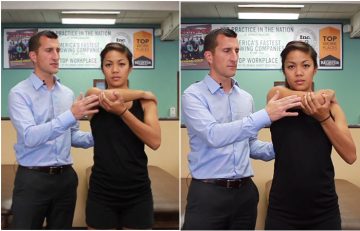
Target – Posterior deltoids, lats, and triceps.
How To Do
- Place the hand of the affected arm on the opposite shoulder. You may use your good arm as support to do so.
- Grab the elbow of the affected arm with your non-injured good arm and raise it to shoulder level.
- Gently and slowly, pull your elbow toward the opposite shoulder. You will feel a stretch along the side and back of your shoulder.
- Hold it for 20 seconds and repeat.
Sets And Reps
2 sets of 20-second holds – 10 repsets of 10 reps
8. Sleeper Stretch
Target – Posterior shoulder
How To Do
- Lie down on the affected side. Keep your arm a little extended out so that it is not directly below your shoulder.
- Flex your elbow and keep your forearm in an upright position.
- Hold the wrist of your affected arm with the other hand.
- Gently push your affected arm down and hold for 10 seconds.
- Release.
Sets And Reps
3 sets of 5 reps.
 Quick Tip
Quick Tip9. Shoulder External Rotation
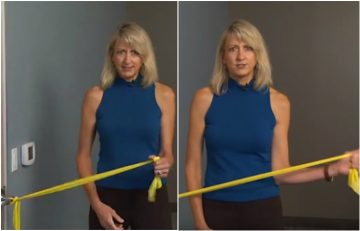
Target – Teres minor, posterior deltoid, and infraspinatus.
How To Do
- Stand near a door with the affected arm facing away from it. Secure a resistance band on the handle of the door. Hold the other end of the resistance band with your affected arm.
- Flex your elbow so that the forearm is perpendicular to the upper arm. This is the starting position.
- Keeping your elbow close to the body, pull the resistance band away from your body.
- Get it back to the starting position and repeat.
Sets And Reps
3 sets of 8 reps
10. Shoulder Internal Rotation
Target – Subscapularis, teres major, and lateral deltoids.
How To Do
- Stand near a door with the affected arm near it. Secure a resistance band on the handle of the door. Hold the other end of the resistance band with the affected arm.
- Bend your elbow such that the forearm is perpendicular to the upper arm. This is the starting position.
- Keep your elbow close to the body and pull the resistance band toward your body.
- Return to the starting position with control and repeat.
Sets And Reps
3 sets of 8 reps
11. Resisted Shoulder Extension
Target – Teres major, lats, posterior deltoids, and triceps.
How To Do
- Stand with your feet shoulder-width apart. Anchor a resistance band in a doorway.
- Hold the other end of the band so your hands are next to your hips. This is the starting position.
- Pull the band and move your elbows back, keeping your shoulders down. Don’t let your shoulders roll forward.
- Return to the starting position with control.
Sets And Reps
3 sets of 8 reps
12. Shoulder Abduction Using A Resistance Band
Target – Deltoid and supraspinatus.
How To Do
- Stand with your feet shoulder-width apart. Secure the resistance band under your shoes and hold the other end of the band with the affected hand. This is the starting position.
- Raise your arm out to the side, palm facing down, and elbow slightly bent, in a slow and controlled motion. Stop when you feel pain.
- Return to the starting position in a slow and controlled motion.
Sets And Reps
3 sets of 10 reps
13. Scaption Raise (With Dumbbells)
Target – Trapezius, serratus anterior, deltoids, and rotator cuff
How To Do
- Stand with your feet at shoulder-width distance.
- Maintain a straight and upright posture.
- Ensure your shoulders are pulled back and down.
- Hold light dumbbells (1-5 lbs) in each hand with the palms facing inward.
- Engage your core muscles and glutes.
- Lift the arms laterally at a 45° angle to form a “Y” shape.
- Lift steadily with controlled movement and let the scapula (shoulder blade) move freely.
- Hold the position for a few seconds, then slowly lower the hands back to the initial position.
- Repeat this movement 8 to 12 times.
Sets And Reps
3 sets of 12 reps
It’s important to stretch your shoulder muscles as well as strengthen them so they don’t become overly tight. Keep reading for healthy shoulder stretches.
Key Takeaways
- Weak muscles and poor posture are the primary causes of rotator cuff injury. Persistent dull pain in your shoulder means you have a rotator cuff injury.
- Trouble lifting your hands, weakness of the shoulders, and increased shoulder pain at night are some of the symptoms of rotator cuff injury.
- Try side-lying external rotation, high-to-low row, reverse fly, and lawnmower pull exercises to strengthen the rotator cuff.
Rotator cuff exercises help reduce shoulder pain and improve the range of mobility. Poor posture, overuse of hand or shoulder muscles, and incorrect techniques can all lead to rotator cuff injury. Weakness in shoulders, trouble reaching behind your back or sleeping on the affected shoulder side may all hint at a rotator cuff or shoulder tendon injury or strain. High-to-low rows, reverse flys, cross-over arm stretches along with the other shoulder rehabilitation exercises mentioned above can help you recover faster from shoulder pain or injury.
Frequently Asked Questions
Can a rotator cuff tear heal on its own?
A rotator cuff tear may not heal on its own without surgery. However, not all rotator cuff injuries need surgery and may heal with exercises and other treatment methods.
What exercises should you avoid with a rotator cuff injury?
Squats with bars, deadlifts, swimming and exercises that put force on the shoulders and have a pulling effect on the arms should be avoided if you have a rotator cuff injury.
Do push ups help rotator cuff?
Deep push-ups should be avoided with a rotator cuff injury. However half push-ups and wall-pushps may help strengthen the rotator cuff when done properly and under supervision.
Is ice or heat better for rotator cuff pain?
Ice is better early on for rotator cuff pain as it may help reduce the inflammation. Heat may be used on injuries that linger beyond 6 weeks and may help loosen up tightened muscles.
Learn the 10 best rotator cuff exercises that can help strengthen and stabilize your shoulder. Check out this video to prevent injuries and improve overall shoulder function.
Personal Experience: Source
StyleCraze's articles are interwoven with authentic personal narratives that provide depth and resonance to our content. Below are the sources of the personal accounts referenced in this article.
i. 1 week post op rotator cuff surgeryhttps://www.youtube.com/watch?v=jCNU8Tvfd5k






